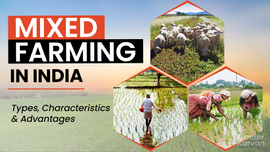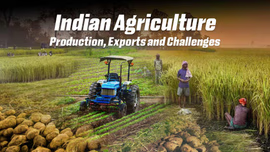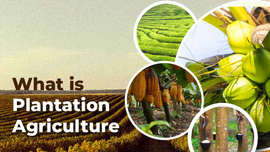Crop Rotation Method for India’s Sustainable Agriculture

Crop rotation is one of the best methods to support sustainable agriculture. It helps improve soil health and achieve higher yields by cultivating different crop types sequentially on the same field. It improves the soil structure and helps manage weeds, pests, and diseases. Let’s dive into the blog to explore the concept of crop rotation, its principles, benefits, major crops used, and related challenges.
Table of Contents
- What is Crop Rotation?
- What are the Principles of Crop Rotation?
- What are the Benefits of Crop Rotation?
- Major Crops Used in Crop Rotation with Regions
- What are the Challenges of Crop Rotation?
- Difference between Crop Rotation and Intercropping
What is Crop Rotation?
Planting two or more crops sequentially on the same piece of land to enhance soil health, optimize nutrients, and combat pest and weed pressure is known as crop rotation. In crop rotation, the succeeding and previous crops are of different genus, species, subspecies, or varieties.
Crop rotation helps achieve better soil quality and its physical, chemical, and biological properties by adding organic matter. This method helps to keep the soil free from pests and diseases, improving crop health and fertility. Farmers achieve higher yields without adding extra expenditure by making the best use of labour power and capital throughout the year.
What are the Principles of Crop Rotation?
Choosing the right crop for the crop rotation can be tricky. Some considerations should be examined when selecting crops for crop rotation. Let’s have a look at the major crop rotation principles below:
- After non-leguminous crops, leguminous crops should be grown and vice versa. Legumes help fix the atmospheric nitrogen and add more organic matter to the soil.
- Exhaustive crops need a high amount of nutrients from the soil. Restorative crops like black gram and potato should follow exhaustive crops as they improve soil health and fertility.
- Deep-rooted crops should alternate with shallow-rooting crops like lentil and castor to improve the soil structure.
- The rotation of monocot crops like rice and wheat with dicot crops is highly beneficial for soil health.
- Foliage crops should follow grain crops like wheat and black gram.
- Foliage drop crops should be rotated with non-foliage drop crops.
- Tolerant trap crops should follow crops at high risk of parasitic weeds and soil-borne pathogens. Examples include pearl millet-castor (for striga) and sugarcane-marigold (for nematodes).
- Other key crop rotation principles include long-duration - short duration crops, field – fodder crops, seed – multi-cut/multi-harvest crops, and dry – wet crops.
What are the Benefits of Crop Rotation?
- Efficient nutrient absorption: Due to crop rotation, crop plants absorb essential nutrients in a balanced manner. It prevents depletion of a single set of nutrients, as the nutrient requirements of crops are not the same. Higher productive crops take up higher levels of nutrients, so the succeeding crop should be chosen considering it utilizes unutilized or residual resources. It gives enough time for the soil to regenerate nutrients.
- Improved soil fertility: Crop rotation helps improve the soil fertility and enhances its health. When crops with varying root systems are grown, it results in the effective utilization of nutrients from different depths of the soil. The restoration of soil fertility occurs due to atmospheric nitrogen fixation, more microbial activity, and the prevention of toxin accumulation.
- Prevents Soil Erosion: Crop rotation prevents soil erosion as it can reduce water and wind erosion by improving soil structure, enhancing water infiltration, and increasing organic matter. Compared to row crops, direct-seeded crops like small grain crops offer better defence against water erosion.
- Insect Pest Management: If one or two crops are grown for a long time, it can lead to a rise in insect populations. Insects form resistance to a specific crop over time. Due to crop rotation, the habitat and feeding habits of insects are disrupted. For example, insects like the stem weevil and maize borer move to other areas without maize.
- Crop Disease Management: Crop rotation can prevent the inoculum of a variety of pathogens. It reduces disease infestations, resulting in effective disease management. For example, Ascochyla phaseolerum can be reduced by a Maize-Cowpea system. Common root rot, ergot, bacterial blights, scab, and tan spot are some diseases that can be controlled by crop rotation.
- Weed Management: Some weed species are found only in a specific crop. Their microclimate favours the growth of weeds, also known as crop-bound weeds. Crop rotation can suppress weeds if suitable crops are selected for rotation. For instance, the sugarcane-wheat system prevents the infestation of Little Canary Grass (Phalaris minor).
Major Crops Used in Crop Rotation with Regions
|
Crop Rotation |
Regions |
|
Rice-pulses, bajra-pulses, sorghum-pulses, groundnut-wheat, soybean-mustard, maize-pulses, or clovers |
Across the country |
|
Rice-pulses, rice-oilseeds; maize-pulses or oilseeds |
Rainfed regions |
|
Rice-wheat; rice – maize; maize- wheat |
Irrigated areas |
|
Rice-mustard |
Eastern UP, Bihar, and Northern West Bengal |
|
Rice- green gram/black gram |
Eastern India (Odisha, West Bengal) |
|
Rice-vegetable; sugarcane-wheat; wheat-vegetable; wheat-pulses; wheat-fallow; sorghum-berseem; maize-mustard; mustard-vegetable; maize-wheat |
Indo-Gangetic Plains
|
What are the Challenges of Crop Rotation?
- Some geographical areas, soil types, and climatic conditions are suitable for certain crops, and thus, they may not favour other crops. Water availability is a major concern for crop rotation. Due to unpredictable water resources, crop rotation cannot be planned effectively.
- Different equipment and machinery are required for different crops. Also, farmers are not able to specialize in a single crop, as different crops must be cultivated in every season.
- It demands a high level of skills and knowledge along with systematic execution. It can be time-consuming for many farmers.
- Another limitation is the allelopathic effect of the preceding crop, where its residues can restrict the growth of succeeding crops.
Difference between Crop Rotation and Intercropping
Crop rotation involves growing different types of crops on the same piece of land sequentially. This practice not only enhances soil health and replenishes nutrient levels but also eliminates weeds and manages pests and diseases. On the other hand, intercropping is planting two or more crops at the same time.
Crop rotation protects crops from pests and diseases, while intercropping reduces the dependency on one crop.
There is a crop rotation method with deep-rooted and shallow-rooted crops, which increases soil fertility. On the contrary, intercropping can facilitate better use of space, water, nutrients, and sunlight.
There is no doubt that crop rotation is a smart and beneficial farming practice for farmers. By adopting such farming practices, farmers can boost their crop yield, rejuvenate soil nutrients, and improve soil fertility. Hence, we can say that crop rotation contributes to long-term agricultural sustainability.
Frequently Asked Questions On Crop Rotation Method for India’s Sustainable Agriculture
1. What do you mean by crop rotation?
Crop rotation involves planting two or more crops sequentially on the same plot of land. It improves soil health, optimizes nutrients, and manages pests and weeds.
2. What are the advantages of intercropping and crop rotation?
Crop rotation increases soil fertility, controls weeds, and manages pests and diseases. Intercropping is known to reduce the risk of crop failure and increase yield.
3. How are crops selected for crop rotation?
Soil structure, conserving nutrients, and weed and pest control are some major considerations to be followed when selecting crops for crop rotation.
4. Why is crop rotation important?
Crop rotation helps to achieve better soil quality and its physical, chemical, and biological properties by adding organic matter.
5. How does crop rotation help soil fertility?
Crop rotation improves soil fertility by improving soil structure, nitrogen-fixing, replenishing nutrients, and controlling pests and diseases.
6. Why should we adopt crop rotation?
We should adopt crop rotation to rejuvenate soil nutrients, improve soil fertility, and encourage sustainable agriculture.


Related Blogs












